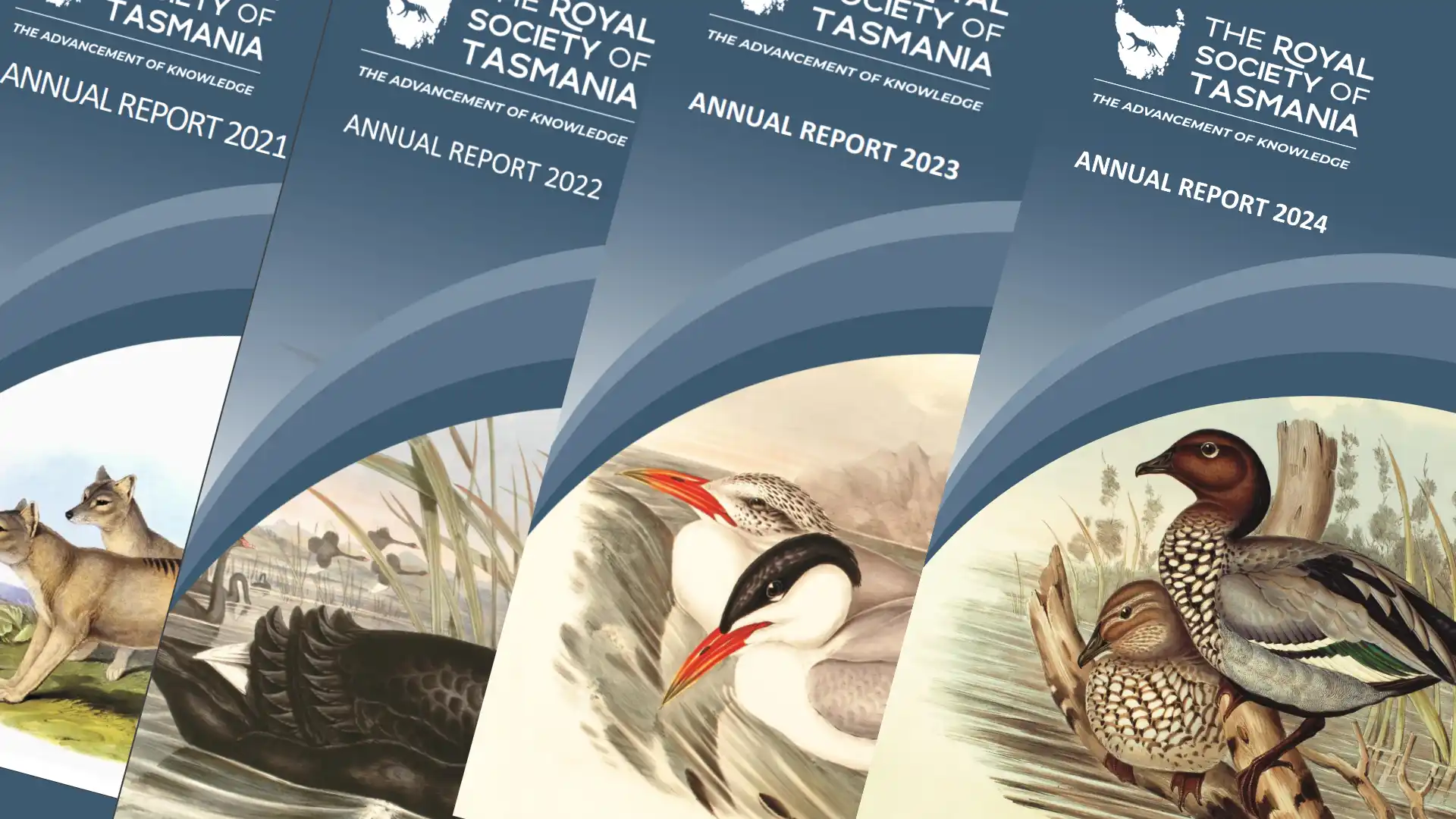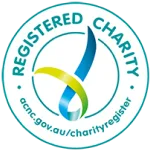
RST Apology to Tasmanian Aboriginal people 2021.

RST Apology to Tasmanian Aboriginal people 2021.

Monthly monitoring was initiated in 2015 and continued for 10 years at 20 peri-urban sites in the Clarence Local Government Area (LGA) in southeast Tasmania to identify the trajectories of bird populations. A total of 869 surveys were undertaken and 78 bird species recorded. The 2 ha survey sites were in a range of locations […]
Drawing on the interpretation of archival information and historical anecdotes, this paper identifies George William Barnard as the author who produced a historic map of King Island, Tasmania, recording information collected in the summer of 1826–1827. These findings ensure the chronology of historical knowledge is maintained and enable institutions to improve metadata for existing copies […]
The Tamar Rift Valley carries evidence of an often-turbulent history during the Cenozoic period. For this research the principal rock units: dolerite, sediments, basalts (vents and flows) and conglomerates, interacting over the past 70 million years were computer modelled. Reconstructions showed that the Longford Basin was integral to the evolution of today’s Tamar Valley, so […]
Louisa Anne Meredith’s successful career as a writer, artist and naturalist has in many respects been well documented. She won numerous national and international awards for her botanical drawings and paintings, and her work as a natural history illustrator has received wide acclaim. Less known, however, is that Meredith’s meticulous illustrations of Tasmanian indigenous fish […]
The distribution and habitat of Engaeus granulatus are reviewed. The species is restricted to a relatively small area in central northern Lutruwita/Tasmania between Devonport in the west, Asbestos Range in the east and Sheffield to the south. The habitat of E. granulatus includes swamps, floodplains of small creeks, poorly-drained areas in paddocks and roadside/railway ditches. […]
As the largest marsupial carnivore of modern times and one of the most well-known recently extinct species, the thylacine, or Tasmanian tiger Thylacinus cynocephalus, continues to be a source of scientific interest and public fascination. Today, over 800 individual thylacine specimens are lodged in the world’s museums, most acquired during the nineteenth and early twentieth […]
An invertebrate fauna survey of Ben Lomond, in the Northeast Highlands of Tasmania, was conducted over the period November 2021 to February 2022 as part of the Tasmanian Museum and Art Gallery’s Expeditions of Discovery program. The survey focused on insects in the higher-elevation parts of the mountain massif, taking in the sub-montane, montane and […]
It is with great sadness that the Royal Society of Tasmania acknowledges the passing of Distinguished Professor James (Jamie) Kirkpatrick AM on 21 October 2024, as one of the Society’s most prestigious long-standing members. It is especially appropriate to publish this tribute in the Papers and Proceedings of the Royal Society of Tasmania because Distinguished […]
Contents page Bryant, S — Vale Distinguished Professor James Barrie Kirkpatrick AM (1946–2024) 1 Griffin, AR, Harbard, JL & Jones, P — Towards an understanding of wind dispersal of Acacia pollen in southeast Tasmania 5 Newman, M & Woehler, EJ — Population trends of woodland bird species in the Clarence Local Government Area, southeast Tasmania […]
A painting from the Royal Society of Tasmania Art Collection travelled to the United States of America in 1941 as part of an exhibition intended to showcase 150 years of Australian art. The exhibition, curated by Professor Theodore Sizer, featured 144 major artworks sourced from leading Australian art galleries, museums and private collections including the […]
Climate change threatens obligate alpine plants with restricted distributions, especially where mountain peaks are not far above the climatic treeline (henceforth treeline), as in Lutruwita/Tasmania where there are at least ten plant species that are only known to occur above the treeline and many more that only occur in alpine vegetation above and below the […]
In St Johns Church in Launceston, Tasmania, there are remarkably accomplished representations of Tasmanian native plants, formed in masonry, all but one decorating capitals consisting of coloured concrete. They were designed by the architect Alexander North, and, with the exception of one carved in sandstone, were executed by Gordon Cumming in 19381939. Possible influences on […]
Crushed agricultural limestone and dolomite are used primarily to increase soil pH (pHw) with its consequent effects on plant nutrient availability and successful introduction of Rhizobium spp. to ensure effective nodulation and nitrogen fixation by pasture and crop legumes. They have also been shown to correct calcium deficiency and, in the case of dolomite, magnesium […]
Two paintings from the Royal Society of Tasmania (RST) Art Collection were selected for an exhibition held in 1951 to celebrate the fiftieth anniversary of the establishment of the Commonwealth of Australia. The Jubilee Exhibition of Australian Art comprised 156 works chosen to represent the best of Australian art from Aboriginal art through early colonial […]
The Tyndall Range, approximately 15 km north of Queenstown and part of the larger West Coast Range, has been chosen as the site for Tasmanias next Iconic Walk, due to open in 2029. The range is composed of siliceous conglomerates and sandstones of Late Cambrian age, within which four formations are recognised. The area was […]
A new species of freshwater crayfish, Engaeus excavator, is described from locations near Latrobe in central northern Tasmania. The species is identified by the elongate fingers of the propodus and carpus of the chelae, and a fringing row of tufts of long flexible setae along the ventral margin of the propodal finger in both large […]
Tasmanias Athrotaxis-dominated woodlands represent a distinctive habitat for lichens and support numerous remarkable species, many of which are endemic to Tasmania and confined to this host tree. In this paper, four further species known only from Tasmania are described as new to science: Amandinea athrotaxiphila Elix & Kantvilas, Catinaria macrospora Kantvilas, Pertusaria comminuta Kantvilas and […]
We report the rediscovery of an attractive geometrid moth, the brown-caped carpet moth, not recorded in Tasmania for more than a century and presumed extinct. Originally described by the French lepidopterist Achille Guenée as Coremia excentrata from a specimen collected near Hobart in 1839 during the French expedition led by Dumont dUrville, it was only […]
This paper is from a lecture presented by Heather Sculthorpe to the Royal Society of Tasmania on 4 August 2024. The address was delivered on Aboriginal land at Piyura Kitina/Risdon Cove and attended by a large audience of RST members and the public. This paper has been published with the authors permission. Keywords:
The concept of continental drift started with the Ancient Greeks. Translation of part of Strabos Ancient Greek manuscript based on Eratosthenes mapping of sub-continental scale, geographic and geologic units which he named sealstones, led to the discovery that he had employed a successful, rectangular co-ordinate, mapping method. As early as c.240220 BCE the detail of […]
As President, I am profoundly honoured to uphold the legacy of the distinguished line of Council Presidents, members, volunteers, advisers, and scholars who have steadfastly dedicated themselves to ensuring The Royal Society of Tasmania remains well-resourced, pertinent, and ready to shape the prosperous future of our State. The Society’s illustrious heritage, spanning over 180 years, […]
The mission of the Royal Society of Tasmania is theadvancement of knowledge. The RST strives to collect, preserve, promote, and make accessible rare,archival and/or primary source materials that advances historical, scientific, cultural, andtechnological knowledge for the benefit of Tasmanians. The RST’s Library and Art Collections werebuilt upon the original foundations of the Society. The Society […]
PRESIDENT’S REPORT In addition to core business, major preoccupations for the Society during 2023 were the RST ArtCollection, a new RST medal, engagement of the Society with the Tasmanian Aboriginal community, and areview of the RST Library Collections at UTAS.There has been significant progress in management of the RST Art Collection. Using a Cultural Heritage […]
The Royal Society of Tasmania (RST) adheres to the Australian Government’s National Privacy Principles, valuing the privacy of its members and website visitors. Personal information—such as name, address, email, and phone number—is collected only when individuals take out a membership or make a booking. This information is stored securely, accessible only to authorised RST personnel, […]
When Louisa Anne Meredith first arrived in colonial Australia she was already an accomplished author and during the remainder of her life here her talents as a gifted painter and illustrator would receive equally high acclaim. At the heart of her work was her love of nature and through her prolific writings and social commentary, […]
Old field succession is the process of vegetation recolonisation of abandoned sites in a passive method of restoration. Slope aspect could be expected to affect the nature of succession after clearance. We investigated variation in paired cleared and uncleared plots between three aspects in grassy woodland in northeastern Tasmania. PERMANOVA was used to assess relationship […]
This paper builds on our existing knowledge of fluorescence in Tasmanian mammals and birds, with 25 new and updated observations comprising two species not previously reported to fluoresce, 12 species previously only reported from museum specimens, and updated information on 11 species, plus two colour-morphs not previously reported. In most cases, the coverage, intensity and […]
Production and sources of agricultural limestone and dolomite in Tasmania are considered in the context of their geology, the acidity of their surface soils, transport and current patterns of use. The Tasmanian Government paid a rail freight subsidy between 1940 and 1980 to encourage on-farm use of ground lime products. Regulations and registration were adopted […]
The organised acclimatisation of animals from one geographical region to another was a widespread movement from the mid-nineteenth century and was common in the Australasian colonies. Previous studies have underplayed or ignored Tas- manias acclimatisation experience as shown by the activities of the Tasmanian Acclimatisation Society, formed in 1862 by a small band of enthusiasts […]


The Royal Society of Tasmania acknowledges, with deep respect, the traditional owners of this land, and the ongoing custodianship of the Aboriginal people of Tasmania. The Society pays respect to Elders past, present and emerging. We acknowledge that Tasmanian Aboriginal Peoples have survived severe and unjust impacts resulting from invasion and dispossession of their Country. As an institution dedicated to the advancement of knowledge, the Royal Society of Tasmania recognises Aboriginal cultural knowledge and practices and seeks to respect and honour these traditions and the deep understanding they represent.

On 15 February 2021, the Royal Society of Tasmania offered a formal Apology to the Tasmanian Aboriginal people.